For Newbies who are seeking information
![]()
For me.... my interest in solar started back in the late 70's... when the
OPEC nations decided to embargo oil and gas shipments, to the US... since there
were already long lines at the gas stations, I worried about heating my house
during the coming winter months.
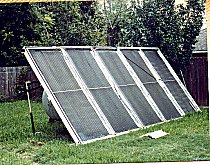
|
These five
Thermal (Heat) Panels could heat my house, even in freezing temperatures
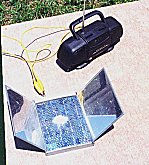
|
A small, 6
volt radio, powered from a Radio Shack PV
Panel
So I bought a cast iron wood
burning heater, and some Thermal (Heat) panels. I also bought a small PV panel
to operate my radio... The wood heater and the Thermal Heat panels did provide
my house with adequate heat, and if the sun was shining, the small Radio Shack
PV panel provided enough power to keep my small, 6 volt radio working, and by
the way, after 22 years, that small PV panel still works OK. I was always
curious how that 6 volt panel could power a radio.
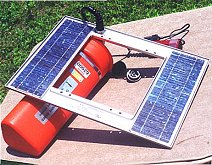
|
A 10 watt
PV panel and battery pack from an ocean
buoy
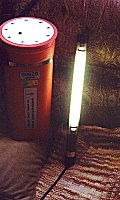
|
Powering a
12 volt 8 watt florescent shop
light
Then... in the middle of 1999, I
was concerned again about another crisis, one that seem to be coming down the
pipeline... it was Y2k. Like others, I had heard all those horror stories about
the coming Y2k disaster, when phones would quit working, and airplanes would
fall out of the sky, and so on. We all know nothing happened on New Years Eve,
but back in the Summer of 1999... it was a hot topic on many of the news media.
So just in case, I decided to make a simple home power system, to provide a
small bit of emergency power if the lights went out. I bought two small, 10 watt
Solar Cell (PV) Panels that were formerly used as a power source for ocean
buoys. Solar Cell panels are sometimes called Photo Voltaics or PV's, because
they convert sunlight into electricity.
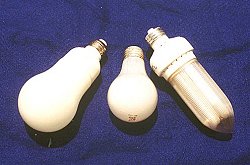
|
The lamp in
the center is an ordinary incandescent (hot) light, and the other two are
Compact Florescent (CF) lights
Fueled
by the fears of Y2k, I wanted to make some more preparations... so I replaced my
house lights with the new (and excellent) Compact Florescent Lights... they use
only 13 to 16 watts of power and deliver the same light as an ordinary
incandescent (hot) bulb... and, I might add, that using these CF lights did
lower my electric bill enough to pay for one light every month.
The
light on the left is an Earthlight, from Phillips, and the light on the right is
from Lights of America... the middle light is an ordinary incandescent (hot)
light bulb.
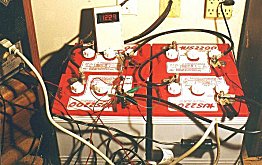
|
Four Golf
Cart Batteries producing 400 Amp Hours
I
also bought four Golf Cart Batteries and a 250 watt StatPower Inverter... the
batteries provide about 400 Amp Hours of energy storage... which is enough power
to operate a CF lamp, my 14 inch TV set, and a small fan for 50 hours, (five, 10
hour days), without recharging the batteries. I actually tested out the system
for the full 50 hours, and everything worked... but... the batteries were
discharged down to 11.30 volts... so... to preserve the life of the batteries, I
did this 50 hour endurance test, only once.
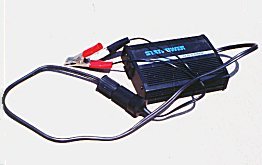
|
Small 250
watt StatPower Inverter
The StatPower
Pro 250 Inverter produces a 120 volt AC Modified Sine Wave, which is good enough
for 99% of all household applications... but, It is limited to 250 watts of
power. I only wanted it for emergency power and was able to buy a refurbished
unit for $61 from Arizona Wind and Sun. It has worked perfectly for about a
year, now, and I am off the grid in parts of my house using only this one, 250
watt, inverter.
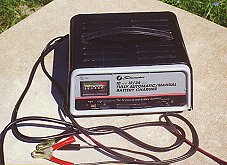
|
A 12 or 24
volt 10 amp, battery Charger
I needed
only one more thing to make my system Y2k ready... and that was a good battery
charger. I found a 10 amp charger that could charge both 12 volt and 24 volt
systems (later I am going to switch to 24 volts, to lower power cable losses).
It was late in December when I got the Charger, Inverter, and Batteries all
hooked together. Then I attached a 6 outlet power strip to my inverter, and
plugged in my bedroom lamp, small fan, and my TV set... and they all worked
flawlessly. I knew my home power would not be interrupted by a storm or any
power outage, ever again.
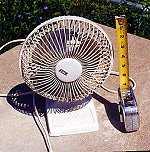
|
My small 7
inch fan stays on all night, with little power
drain
As you all know, Y2k came and
went, and nothing happened... so... you might ask, does the story end there?
Actually no... I still had the batteries and the the inverter, and in January of
this year, I had visions of even greater things...(sounds dramatic, doesn't it?)
You have to understand that the Y2k system only costs me about $250 for
the Golf Cart Batteries, then there was $61 for the Inverter, and another $67
for the Battery Charger... and this simple, (and cheap) investment provides my
home with some power during any storm, or hurricane (I live in Houston), or any
future problem that may happen to the grid. In fact, I could provide myself,
this limited power for several days if there was a prolonged power interuption.
But... after five days or so, the batteries would have to be recharged
by the battery charger (the grid)... so the system was not independent from the
grid, at least, it wasn't then.
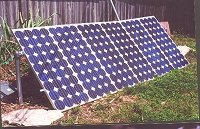
|
Six 90 watt
PV's hooked up in
January
In January,
right after Y2k passed, I found a source of high quality 90 watt, PV's for $4 a
watt... and purchased 12 panels. I connected six of the PV's to my battery
array, which now provides me enough power to discontinue using the battery
charger. The system works so well, that even on cloudy days there is sufficient
electrical power stored into the batteries, to run the TV, some CF lights, and a
fan. Soon, I will have the other six PV's installed, which will probably produce
enough power for a solar type refrigerator.
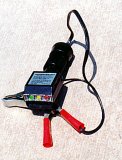
|
A cheap
battery indicator
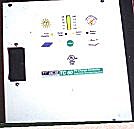
|
A Trace
TC60 Battery Controller
When I first set
up my PV's, I needed a way to monitor the condition of the batteries. So I
bought a automotive cigarette lighter plug-in battery indicator... you can see
it at the left. I still have it attached today, but... I also have a Charge
Controller, which limits the input voltage to the batteries, so that they will
not be overcharged on bright sunny days.
The advantage of the small
three LED battery indicator, is that I can always see, at a glance, the voltage
level in my batteries. Since the battery indicator only costs me about $5, it
was cheap insurance.
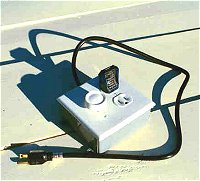
|
A home
built dimmer switch for the battery
charger
And do you remember that 12 volt
battery charger I started out with? It turns out that this charger worked fine,
with two Golf Cart Batteries (12 volts), but strained a bit when I expanded my
battery array to 4 batteries. Now I use 8 Golf Cart Batteries, and when I have
several days of cloudy weather, and need to recharge the batteries (from the
grid), the charger overloads and trips out from heat overload.
To stop
this, I built a inexpensive Dimmer Switch to plug my battery charger into, so
that the input current can be controlled by turning the knob on the dimmer box.
I can adjust the output amps of the charger, so that it operates under its
maximum limit and doesn't trip out from heat overload.
![Statpower ProWatt 1500]()
|
A Statpower
ProWatt1500 Inverter
![Brand 4-1850 Watt Meter]()
|
I use a
Brand Watt Meter to check the loads of all my
appliances
By October of 1991, I had
added more PV panels... so that now, 8 panels are on line... With that extra
power and the 8 Golf Cart Batteries, I was able to take my old, 75 Mhz pentium
computer off the grid. I even went a step further, and bought a refurbished
Statpower ProWatt 1500 watt inverter. I needed the bigger inverter to see if it
was possible to take my microwave oven off the grid, too.
I also bought
a Brand 4-1850 Watt Meter to measure various power loads around the house. It is
a handy tool to have for home power work.
In the beginning, I
only wanted to have an emergency back-up power during Y2k, or when there was a
power outage.... but now, it seems, that part of my house is permanently
off-grid.
Anyway... I hope this history of my experiences will serve as
a kind of tutorial on how to hook up your own PV system.
Gig















